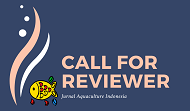PENGARUH LEVEL RATIO C:N TERHADAP NITROGEN TAK ORGANIK DALAM AIR YANG MENGGUNAKAN MOLASES SEBAGAI SUMBER KARBON
Abstract
Keywords
Full Text:
PDFReferences
Avnimelech, Y., Lacher, M., Raveh, A., & Zur, O. (1981). A method for the evaluation of conditions in a fish pond sediment. Aquaculture, 23(1–4), 361–365. https://doi.org/10.1016/0044-8486(81)90029-6
Avnimelech, Y., Mozes, N., & Weber, B. (1992). Effects of aeration and mixing on nitrogen and organic matter transformations in simulated fish ponds. Aquacultural Engineering, 11(3), 157–169. https://doi.org/10.1016/0144-8609(92)90002-F
Azam, F., Fenchel, T., Field, J., Gray, J., Meyer-Reil, L., & Thingstad, F. (1983). The Ecological Role of Water-Column Microbes in the Sea. Marine Ecology Progress Series, 10(3), 257–263. https://doi.org/10.3354/meps010257
Billen, G. (1984). Heterotrophic Utilization and Regeneration of Nitrogen. In J. E. Hobbie & W. P.J.L (Eds.), Heterotrophic Activity in the Sea (pp. 313–355). Springer US. https://doi.org/10.1007/978-1-4684-9010-7_15
Bovendeur, J., Zwaga, A., Lobee, B., & Blom, J. (1990). Fixed-biofilm reactors in aquacultural water recycle systems: effect of organic matter elimination on nitrification kinetics. Water Research, 24(2), 207–213. https://doi.org/10.1016/0043-1354(90)90104-E
Boyd, C. E., & Massaut, L. (1999). Risks associated with the use of chemicals in pond aquaculture. Aquacultural Engineering, 20(2), 113–132. https://doi.org/10.1016/S0144-8609(99)00010-2
Burford, M. A., Thompson, P. J., McIntosh, R. P., Bauman, R. H., & Pearson, D. C. (2003). Nutrient and microbial dynamics in high-intensity, zero-exchange shrimp ponds in Belize. Aquaculture, 219(1–4), 393–411. https://doi.org/10.1016/S0044-8486(02)00575-6
Chuntapa, B., Powtongsook, S., & Menasveta, P. (2003). Water quality control using Spirulina platensis in shrimp culture tanks. Aquaculture, 220(1–4), 355–366. https://doi.org/10.1016/S0044-8486(02)00428-3
Figueroa, L. A., & Silverstein, J. (1992). The effect of particulate organic matter on biofilm. Water Environ. Res, 64(5), 728 – 733. http://www.jstor.org/stable/25044214%0A
Fuhrman, J., Horrigan, S., & Capone, D. (1988). Use of 13N as tracer for bacterial and algal uptake of ammonium from sea-water. Marine Ecology Progress Series, 45(3), 271–278. https://doi.org/10.3354/meps045271
Goldman, J. C., Caron, D. A., & Dennett, M. R. (1987). Regulation of gross growth efficiency and ammonium regeneration in bacteria by substrate C: N ratio1. Limnology and Oceanography, 32(6), 1239–1252. https://doi.org/10.4319/lo.1987.32.6.1239
Hargreaves, J. A. (1998). Nitrogen biogeochemistry of aquaculture ponds. Aquaculture, 166(3–4), 181–212. https://doi.org/10.1016/S0044-8486(98)00298-1
Helder, W., & De Vries, R. T. P. (1983). Estuarine nitrite maxima and nitrifying bacteria (Ems-Dollard estuary). Netherlands Journal of Sea Research, 17(1), 1–18. https://doi.org/10.1016/0077-7579(83)90002-9
Hoch, M. P., Fogel, M. L., & Kirchman, D. L. (1994). Isotope fractionation during ammonium uptake by marine microbial assemblages. Geomicrobiology Journal, 12(2), 113–127. https://doi.org/10.1080/01490459409377977
Hopkins, J. S., Hamilton, R. D., Sandier, P. A., Browdy, C. L., & Stokes, A. D. (1993). Effect of Water Exchange Rate on Production, Water Quality, Effluent Characteristics and Nitrogen Budgets of Intensive Shrimp Ponds. Journal of the World Aquaculture Society, 24(3), 304–320. https://doi.org/10.1111/j.1749-7345.1993.tb00162.x
Keil, R., & Kirchman, D. (1991). Contribution of dissolved free amino acids and ammonium to the nitrogen requirements of heterotrophic bacterioplankton. Marine Ecology Progress Series, 73(1), 1–10. https://doi.org/10.3354/meps073001
Kirchman, D. L., Keil, R. G., & Wheeler, P. A. (1990). Carbon limitation of ammonium uptake by heterotrophic bacteria in the subarctic Pacific. Limnology and Oceanography, 35(6), 1258–1266. https://doi.org/10.4319/lo.1990.35.6.1258
Kochba, M., Diab, S., & Avnimelech, Y. (1994). Modeling of nitrogen transformation in intensively aerated fish ponds. Aquaculture, 120(1–2), 95–104. https://doi.org/10.1016/0044-8486(94)90225-9
Middelboe, M., Borch, N., & Kirchman, D. (1995). Bacterial utilization of dissolved free amino acids, dissolved combined amino acids and ammonium in the Delaware Bay estuary:effects of carbon and nitrogen limitation. Marine Ecology Progress Series, 128, 109–120. https://doi.org/10.3354/meps128109
Montoya, R. A., Lawrence, A. L., Grant, W. E., & Velasco, M. (2002). Simulation of inorganic nitrogen dynamics and shrimp survival in an intensive shrimp culture system. Aquaculture Research, 33(2), 81–94. https://doi.org/10.1046/j.1365-2109.2002.00650.x
Moriarty, D. J. W. (1986). Bacterial productivity in ponds used for culture of penaeid prawns. Microbial Ecology, 12(3), 259–269. https://doi.org/10.1007/BF02011169
Ohashi, M., de Vries, K. J., Frank, R., Snoek, G., Bankaitis, V., Wirtz, K., & Huttner, W. B. (1995). A role for phosphatidylinositol transfer protein in secretory vesicle formation. Nature, 377(6549), 544–547. https://doi.org/10.1038/377544a0
Parsons, T. R., Albright, L. J., Whitney, F., Wong, C. S., & Williams, P. J. L. B. (1981). The effect of glucose on the productivity of seawater: An experimental approach using controlled aquatic ecosystems. Marine Environmental Research, 4(3), 229–242. https://doi.org/10.1016/0141-1136(81)90037-4
Tezuka, Y. (1990). Bacterial regeneration of ammonium and phosphate as affected by the carbon:nitrogen:phosphorus ratio of organic substrates. Microbial Ecology, 19(3), 227–238. https://doi.org/10.1007/BF02017167
Visscher, P. T., & Duerr, E. O. (1991). Water Quality and Microbial Dynamics in Shrimp Ponds Receiving Bagasse-Based Feed. Journal of the World Aquaculture Society, 22(1), 65–76. https://doi.org/10.1111/j.1749-7345.1991.tb00718.x
Wheaton, F. . (1994). Nitrification Filter Principles. In M. . Timmons & T. . Losordo (Eds.), Aquaculture Water Reuse Systems: Engineering Design and Management (1st ed., p. 348). Elsevier Science.
Wong, H.-C., Chen, M.-C., Liu, S.-H., & Liu, D.-P. (1999). Incidence of highly genetically diversified Vibrio parahaemolyticus in seafood imported from Asian countries. International Journal of Food Microbiology, 52(3), 181–188. https://doi.org/10.1016/S0168-1605(99)00143-9
Yao, S., Shufang, Z., Jufa, C., & Yunli, S. (2001). Supplement and consumption of dissolved oxygen and their seasonal variations in shrimp pond. Marine Science Bulletin, 3(2).
DOI: https://doi.org/10.46576/jai.v1i1.1554
Article Metrics
Abstract view : 755 timesPDF – 341 times
Refbacks
- There are currently no refbacks.
Copyright (c) 2021 Pohan Panjaitan, Helentina Mariance Manullang

This work is licensed under a Creative Commons Attribution-NonCommercial-ShareAlike 4.0 International License.
Jurnal AQUACULTURE Indonesia [JAI] telah terindex pada
JURNAL AQUACULTURE INDONESIA [JAI] published by :
PROGRAM STUDI AKUAKULTUR, FAKULTAS PERIKANAN, UNIVERSITAS DHARMAWANGSA
Alamat : Jl. K. L. Yos Sudarso No. 224 Medan
Kontak : Tel. 061 6635682 - 6613783 Fax. 061 6615190
Surat Elektronik : jai_dw@dharmawangsa.ac.id
Jurnal AQUACULTURE Indonesia by Universitas Dharmawangsa is licensed under a Creative Commons Attribution-NonCommercial-ShareAlike 4.0 International License.
Based on a work at http://jurnal.dharmawangsa.ac.id/index.php/akuakultur/index




.png)














